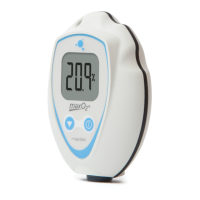1.4 MAX-250+ Oxygen Sensor
The MAX-250+ oxygen sensor offers stability and extra life.
The MAX-250+ is a galvanic, partial pressure sensor that is specific to
oxygen. It consists of two electrodes (a cathode and an anode), a teflon
membrane and an electrolyte. Oxygen diffuses through the teflon membrane
and immediately reacts at a gold cathode. Concurrently, oxidation occurs
electrochemically at the lead anode, generating an electrical current and
providing a voltage output. Electrodes are immersed in a unique gelled weak
acid electrolyte which is responsible for the sensors long life and motion
insensitive characteristic. Since the sensor is specific to oxygen, the current
generated is proportional to the amount of oxygen present in the sample gas.
When no oxygen is present, there is no electrochemical reaction and there-
fore, negligible current is produced. In this sense, the sensor is self-zeroing.
CAUTION: The Maxtec MAX-250+ oxygen sensor is a sealed device
containing a mild acid electrolyte, lead (Pb), and lead acetate. Lead
and lead acetate are hazardous waste constituents and should be
disposed of properly, or returned to Maxtec for proper disposal or
recovery.
CAUTION: Do not immerse the sensor in any cleaning solution,
autoclave or expose the sensor to high temperatures.
CAUTION: Dropping sensor can adversely affect its performance.
Do not throw away. Dispose of properly in accordance with local
regulations.
2.0 OPERATING INSTRUCTIONS
2.1 Getting Started
2.1.1 Protect Tape
Prior to turning on the unit, a protective film covering the threaded sensor
face must be removed. After removing the film, wait approximately 20
minutes for the sensor to reach equilibrium.
2.1.2 Automatic Calibration
After the unit is turned on it will automatically calibrate to room air. The
display should be stable and reading 20.9%. To check the oxygen concen-
tration of a sample gas: (after the unit has been calibrated).
3
WWW.MAXTEC.COM

